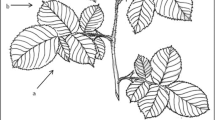Abstract
The adverse side effects of caffeine1 have increased the market for decaffeinated coffee to about 10% of coffee consumption worldwide (http://www.ncausa.org), despite the loss of key flavour compounds in the industrial decaffeinating process. We have discovered a naturally decaffeinated Coffea arabica plant from Ethiopia, a species normally recognized for the high quality of its beans. It should be possible to transfer this trait to commercial varieties of arabica coffee plants by intraspecific hybridization — a process likely to be simpler than an interspecific hybridization strategy, which could require more than 30 years of breeding to fix the decaffeinated trait and would probably result in an inferior cup of coffee.
Similar content being viewed by others
Main
Coffea arabica is the most cultivated and consumed coffee in the world. Attempts to transfer the caffeine-free property from wild coffee species of Madagascar, which produce an inferior beverage, to C. arabica have failed owing to a strong genetic barrier2,3: C. arabica is an autogamous (over 95% self-pollinating) allotetraploid (2n = 4× = 44), whereas all other coffee species are diploid and allogamous (none is self-pollinating).
Biotechnological attempts have also been made to interfere with caffeine production by preventing the expression of genes that encode key enzymes in the caffeine biosynthesis pathway4, culminating in the production of a transgenic Coffea canephora with a 50–70% reduction of caffeine in the leaves5.
As part of a genetic breeding programme to reduce caffeine, initiated in 1987 at the Instituto Agronômico de Campinas, we have studied 3,000 coffee trees, representing 300 C. arabica accessions from Ethiopia6,7. We found that three of these Ethiopian plants (designated here as AC1, AC2 and AC3 in honour of the geneticist Alcides Carvalho) were almost completely free of caffeine. They were detected during routine high-performance liquid chromatography (HPLC) of methanolic extracts of seeds. The seeds of these plants showed a mean caffeine content of 0.76 mg g−1 dry weight; Mundo Novo (MN), a commercial cultivar of C. arabica, contains 12 mg g−1. The leaves and other parts of the fruit were also very low in caffeine.
We found that AC plants accumulated theobromine (about 6.1 mg g−1 dry weight; Fig. 1a), the immediate precursor of caffeine8, indicating that these plants might be deficient in the enzyme caffeine synthase, which acts on theobromine. To test this, we infiltrated AC1 and MN leaves under vacuum with 14C-caffeine or 14C-adenine to monitor their degradation or their conversion to caffeine, respectively, in these plants. The radioactivity incorporated into metabolites was analysed after 4, 21 and 48 h of incubation by using HPLC coupled to ultraviolet and radioactivity detection systems9. (For methods, see supplementary information.)
a, High-performance liquid chromatography (left) and thin-layer chromatography (right) profiles of methanolic extracts from leaves of AC1 and MN cultivars. Cf, caffeine; Tp, theophylline; Tb, theobromine; STDs, standards. b, c, Metabolism of exogenous 14C-caffeine (b) or 14C-adenine (c) in leaves of AC1 and MN plants to theobromine (circles) and caffeine (triangles).
The exogenous radiolabelled caffeine was degraded in both AC and MN plants (Fig. 1b). We found traces of radioactivity in theophylline, the first degradation product of caffeine, in both cases (results not shown). Theobromine can also occur as a degradation product of caffeine and although some radioactivity in theobromine was detected after treatment, this was minimal in both cases (Fig. 1b). These results indicate that the naturally low caffeine content in AC1 plants relative to MN plants is unlikely to be due to enhanced degradation of caffeine.
AC1 leaves accumulated radioactivity in theobromine when 14C-labelled adenine was fed to the plant, with none being incorporated into caffeine (Fig. 1c). By contrast, the amount of labelled theobromine in MN leaves decreased as the label became incorporated into caffeine (Fig. 1c). Because no caffeine synthase activity is detectable in AC1 leaves9, we conclude that the caffeine synthase gene is mutated in these AC plants.
Theobromine is the main alkaloid in cacao seeds (22–27 mg g−1 dry weight) and has diuretic properties10; its effects may be similar to but much smaller than those of caffeine1. However, its effects in AC1 coffee remain to be investigated. Information about cup quality and plant productivity is not yet available for AC plants but, given that C. arabica has a narrow genetic diversity and that even accessions from Ethiopia and Arabia (now Yemen), as well as old varieties, all produce high-quality coffee11, it is likely that AC plants will produce a good beverage.
AC plants all belong to the same accession, represented by 12 plants, which suggests that there has been segregation for the low-caffeine trait. We believe that by using a conventional breeding approach this trait could be successfully transferred to highly productive cultivars of C. arabica, because hybridizations will occur inside the same autogamous species. Our results highlight the value of maintaining and characterizing field germplasm collections.
References
James, J. E. Caffeine and Health (Academic, San Diego, 1991).
Charrier, A. La Structure Génétique des Caféiers Spontanés de la Région Malgache (Mascarocoffea). Leurs Relations avec les Caféiers d'Origine Africaine (Eucoffea) (Orstom, Paris, 1978).
Mazzafera, P. & Carvalho, A. Euphytica 59, 55–60 (1992).
Kato, M. & Mizuno, K. Front. Biosci. 9, 1833–1842 (2004).
Ogita, S., Uefuji, H., Yamaguchi, Y., Koizumi, N. & Sano, H. Nature 423, 823–823 (2003).
FAO Report: Coffee mission to Ethiopia 1964–65 (Food and Agriculture Organization, Rome, 1968).
Silvarolla, M. B., Mazzafera, P. & Lima, M. M. A. Gen. Mol. Biol. 23, 213–215 (2000).
Ashihara, H. & Suzuki, T. Front. Biosci. 9, 1864–1876 (2004).
Mazzafera, P., Crozier, A. & Sandberg, G. J. Agric. Food Chem. 42, 1423–1427 (1994).
Evans, W. C. Trease and Evan's Pharmacognosy (Saunders, London, 1996).
van der Vossen, H. A. M. in Coffee — Botany, Biochemistry and Production of Beans and Beverage (eds Clifford, M. N. & Wilson, K. C.) 48–107 (Helm, London, 1985).
Author information
Authors and Affiliations
Corresponding author
Ethics declarations
Competing interests
The authors declare no competing financial interests.
Supplementary information
Rights and permissions
About this article
Cite this article
Silvarolla, M., Mazzafera, P. & Fazuoli, L. A naturally decaffeinated arabica coffee. Nature 429, 826 (2004). https://doi.org/10.1038/429826a
Issue Date:
DOI: https://doi.org/10.1038/429826a
This article is cited by
-
A chromosome-scale assembly reveals chromosomal aberrations and exchanges generating genetic diversity in Coffea arabica germplasm
Nature Communications (2024)
-
The biological feasibility and social context of gene-edited, caffeine-free coffee
Food Science and Biotechnology (2022)
-
Molecular characterization of Arabica Coffee (Coffea arabica L.) germplasms and their contribution to biodiversity in Ethiopia
Plant Biotechnology Reports (2021)
-
The absence of the caffeine synthase gene is involved in the naturally decaffeinated status of Coffea humblotiana, a wild species from Comoro archipelago
Scientific Reports (2021)
-
Identification and characterization of N9-methyltransferase involved in converting caffeine into non-stimulatory theacrine in tea
Nature Communications (2020)
Comments
By submitting a comment you agree to abide by our Terms and Community Guidelines. If you find something abusive or that does not comply with our terms or guidelines please flag it as inappropriate.




